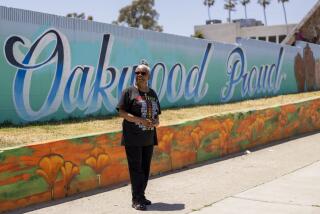Venice High’s Magnet Classes Circle the Globe
- Share via
Americans’ lack of knowledge, understanding or even curiosity about the rest of the world has become something of a cultural joke. Every so often a survey shows that many American students can’t find the Mississippi River, let alone Moscow, on a map.
So it was hardly surprising that, within hours of the horrible events of Sept. 11, some commentators began ruing Americans’ insularity. But don’t paint John Brierley’s students at Venice High School with that broad brush.
“High schoolers like us actually care” about the rest of the world, said Jin Huang, 17. “We don’t discuss clothes and shopping.”
Even before the Sept. 11 attacks, students in the international studies magnet program discussed cultural and political clashes among nations, learned about the intricacies of diplomacy and studied foreign languages.
Brierley, a 35-year classroom veteran, is a mainstay of Venice’s magnet program. He teaches geography as well as international relations, delighting in his students’ talents and insights.
On the day of the devastating attacks, Brierley abandoned his prepared lesson for his international-relations students. The new topic for discussion became proportional response, a long-standing concept in American foreign policy in which reaction to an offense is consistent with its severity.
Brierley’s students since have learned how enemies demonize one another. They engage in diplomatic exercises that challenge them to see things from other countries’ points of view.
During classroom discussions, students learn how geography, history, culture and politics are connected.
“We looked at how close Pakistan and Afghanistan were to Russia to see if there’d be a large amount of refugees from the war into the country,” said Blair Ladd, 17.
Jonathan Kvitky, 17, said he worries that hostilities in Afghanistan may expose tensions among other countries in the region. That, he said, could lead to a regional war.
“We’re talking about a part of the world where every country hates its neighbors, not just the U.S.,” he said.
One reason the Taliban hates the U.S., said Klaude Kimura, 16, has to do with how the U.S. “abandoned them after the Cold War.” The country’s proximity to the Soviet Union, in turn, makes it feel vulnerable.
“That’s why geography is pretty important,” he said.
Over the last decade or so, recognition of that basic truth has led to a resurgence in geography education. National and state geography standards have been written for what students need to know in social studies. Since last year, there has been an advanced placement test in geography, which, if passed, allows students to earn college credits while in high school.
There’s far more to geography than being able to find a country on the globe and committing to memory its capital, population, terrain and main exports, said Brierley.
Steve Cunha, a geography professor at Humboldt State, said, “Place names are to geography what the alphabet is to reading. They’re just a starting point.
“Those who can name every state and capital and river and mountain don’t necessarily know geography because the core of it is knowing the interrelationships within and between places and people who live there,” said Cunha, who heads the California Geographic Alliance, an organization that seeks to promote and improve geography education.
Cunha said he’s already talked to U.S. soldiers who are “itching to get over to Afghanistan” and fight.
“I’m confident they know weaponry and military procedure, but I don’t think they have a clue about what it’s like to fight a war at 14,000 feet,” he said.
What students--and soldiers and politicians--need is the ability to think geographically. Without that, said Nick Entrikin, a UCLA geographer who works with a statewide teacher training project in social studies, facts about a place will be meaningless and will be quickly forgotten.
“This is what happens when we try to cram geographic knowledge into kids’ minds,” he said. “There’s no adhesive quality to it.”
The most recent national evaluation of American students’ knowledge of geography suggests there is a long way to go. Results of a national assessment released in 1996 found that only 25% of students were proficient in geography, and only a handful had gained “advanced” understanding of the topic.
About 75% of the seniors tested could find on a map cities such as Rome, Jerusalem and Mecca. But only half understood broader geographic concepts such the role of the automobile in the formation of suburbs.
To reverse that, Brierley said, students need to begin learning geography, including the interrelationships among countries, from an early age.
“We complain about kids who can’t do basic math in the ninth grade and about kids in high school who can’t write a paragraph,” he said. “It’s the same in geography. There’s many kids who don’t have the foundation.”
Brierley, 59, was a geography minor at USC. But he didn’t start teaching the subject until 11 years ago, after getting involved with geography instructors statewide.
Before Sept. 11, his students, like most Americans, knew little about Afghanistan. They knew its location, that it had been torn by a power struggle and that women were all but confined. Since then, they’ve learned about its terrain, climate, history and culture.
They’ve also learned what may be the most important lesson of all. They know that our lack of knowledge about the rest of the world makes us vulnerable.
“They caught us,” said 17-year-old Brooks Bonvenuto, whose backward ball cap and T-shirt make him seem the prototypical American teen. “We had this attitude of being the biggest and the best and strongest and that we didn’t have to worry. All of a sudden, bam, it’s like we’re not as big and bad as we thought we were.”
for CLASS1
More to Read
Sign up for Essential California
The most important California stories and recommendations in your inbox every morning.
You may occasionally receive promotional content from the Los Angeles Times.













